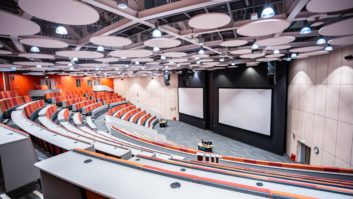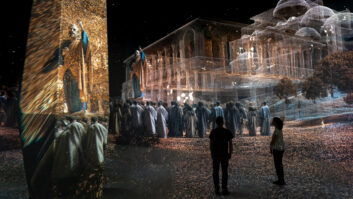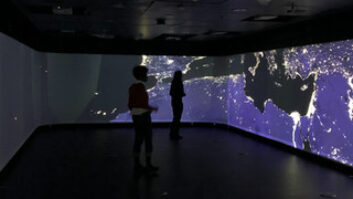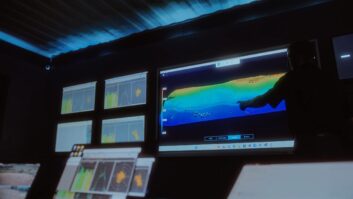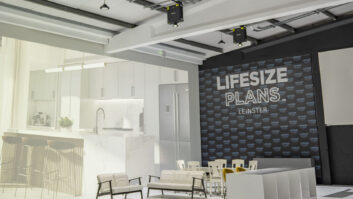The historic Queen’s College, founded in 1341, is one of the constituent colleges of the University of Oxford. Renowned for its late 17th and early 18th-century architecture, the brand new Schulman auditorium brings the college into the 21st century. The auditorium is unusual in that it is a modern, glass-ended building, erected between two original and historically significant brick walls. As such, the site has listed status and the audio visual solution needed to take account of the restrictions this imposed. The single largest restriction was that the walls could not be used for the fixing of any hardware. This demanded creative thinking and innovative solutions to achieve the technical requirements whilst taking account of this constraint.@page_break@
Designed to be a flexible space, the auditorium’s primary use is as a lecture theatre for teaching purposes during term time, and for conferences during holiday periods. As such the ability to hear what speakers are saying with clarity and to precisely display any presentation, notes, demonstrations or videos is crucial. The auditorium will also host chamber concerts based around small choral groups, chamber groups such as trios and quartets, and piano recitals. A Steinway grand piano has been installed with this in mind, which will live permanently in the auditorium. In the lecture theatre, a single ceiling mounted Christie 7000 ANSI lumen WXGA LCD projector is the main display device and is bright enough to cope with the high ambient light conditions. Mounted in the bespoke AV room, the projector is totally discreet and does not impact on the striking architecture of the room. Interchangeable lenses ensure that the correct size image is achievable.@page_break@The listed building restrictions meant that the projection screen could not be wall mounted. Reflex worked closely with the main contractor to create a floor recess to house an electric 133-inch diagonal rise and fall screen, which disappears from view when not required. With a 16:10 ratio to match the projector’s resolution, it is a large, heavy screen that demanded several people to manoeuvre it into place. Two lecterns have been installed in the lecture theatre. One has no built-in technology, from which a presenter will be able to use a wireless touch panel controller and a wireless microphone, the other is a rise-and-fall unit. Fixed to this is a Smart 15-inch interactive pen display for interactivity with the projected image. A variety of different inputs have been included as part of the specification, such as a resident PC, laptop, bluray player, document camera, and FreeSat receiver. A 19-inch TFT monitor is installed in the AV room for monitoring and preview of sources for display. From here, technicians can position a PTZ camera ready for recording of activity in the lecture theatre. The audio system was very important with full programme sound and speech reinforcement required. This is achieved by the use of long throw column speakers from Tannoy, subwoofers and low profile flush mounting speakers. All three systems are driven by an Ecler NZA amplifier. An ‘always live’ infrared hard of hearing system is installed. A combination of lapel and handheld microphones, as well as a switched lectern mic ensure optimum sound reproduction.@page_break@In the foyer, a 40-inch, wall-mounted Samsung LCD display with in-built digital signage player and network PC is connected to a pair of ceiling-recessed speakers for relay of audio. Linked to the lecture theatre via a switching system, it provides a flexible facility, which can show an image from the lecture theatre, to allow speakers to know when to enter the room. It’s also used for displaying important information such as the running order of presentations at a conference. In the Green Room, an area for the preparation of refreshments and for performers to change, a 32-inch LCD screen is wall-mounted showing any image from the lecture theatre. Control of the system is via a Crestron Digital Media system, one of Crestron’s newest products and capable of High Definition audio and video distribution. This installation was challenging, as it needed to reflect the diverse uses to which the auditorium would be put. Firstly, as a state-of-the-art lecture room for conferences and presentations, the audio system for speech had to be of the highest quality, coupled with high definition video facilities, ranging from computer presentations to satellite video feeds. Secondly, programme stereo sound for high fidelity audio presentations from CDs and DVDs was essential. “We were delighted that Reflex was able to meet all our specifications in a system which combines ease of use for delegates and powerful options for our technical staff in a discreet and elegant installation, in keeping with the architectural design of the auditorium,” said Professor Robert Taylor of Queen’s College. www.reflex.co.uk
Case study – Reflex brings 18th century Queen’s College Oxford bang up to date
How does a modern audio visual solution fit into listed Queen’s College Oxford? TFA looks at the solution devised by Reflex at the new Schulman auditorium.
